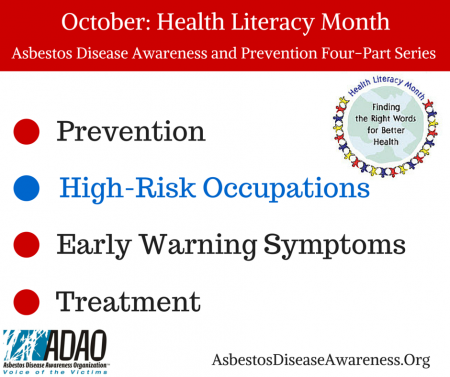Posted on October 10, 2016
Health Literacy Month Landing Page
Part One: Prevent Asbestos Exposure
Part Two: Recognize High Risk Occupations
Part Three: Understand the Warning Symptoms for Asbestos-Caused Diseases
Part Four: Finding a Center of Excellence for Treatment
Diseases
Part Four: Finding a Center of Excellence for Treatment
Important Notice: ADAO does not make medical diagnoses, recommend treatment or answer specific patient questions. Specific concerns should be addressed directly by your treating physician.
“The asbestos issue is not a thing of the past. It continues to this day. — Acting U.S. Surgeon General Boris Lushniak

According to the National Cancer Institute (NIH), people who become ill from asbestos are usually those who are repeatedly exposed, most often “from a job where staff work directly with the material or through substantial environmental contact.” With asbestos fibers contained in a range of building and construction products, the risk of “substantial environmental contact” from these fibers becoming disturbed and released into the air is continual. Since the 1940s, NIH reports millions of workers in the United States have been exposed.
ADAO recommends familiarizing yourself with the Occupational Safety and Health Administration’s “Asbestos Fact Sheet” about asbestos exposure in the workplace.
Occupations with a high-risk of asbestos exposure include, but are not limited to, the following:
- Workers involved in the manufacture of asbestos products
- Asbestos mining and milling
- Construction trades (including insulators, sheet metal workers, electricians, plumbers, pipe fitters, and carpenters)
- Power plant workers
- Boilermakers
- Shipyard workers
- Firefighters
- Teachers
- Veterans
There is a very long latency period between exposure and the onset of symptoms, which typically happens 10 – 50 years after exposure. NIH reports investigators have found those who develop asbestos diseases can do so both after long and short exposures. You can also show symptoms as an adult if, as a child, you were exposed to a parent who came home with asbestos dust on their clothing. Early symptoms are generally vague and can be confused with other illnesses, such as pneumonia (we will address early warning symptoms in next week’s Part 3 installment of this Health Literacy Month series). If you are concerned that you might be experiencing asbestos disease symptoms, talk to your doctor about possible occupational or environmental asbestos exposure. Only a doctor can properly diagnose asbestos-related diseases.
To access more information about symptoms, refer to the National Cancer Institute’s “Asbestos Exposure and Cancer Risk” Fact Sheet and visit us again on October 17 for Part Three of our Health Literacy Month blog: Early Warning Symptoms.
As we say at ADAO, “Hear Asbestos. Think Prevention.”
Linda Reinstein
